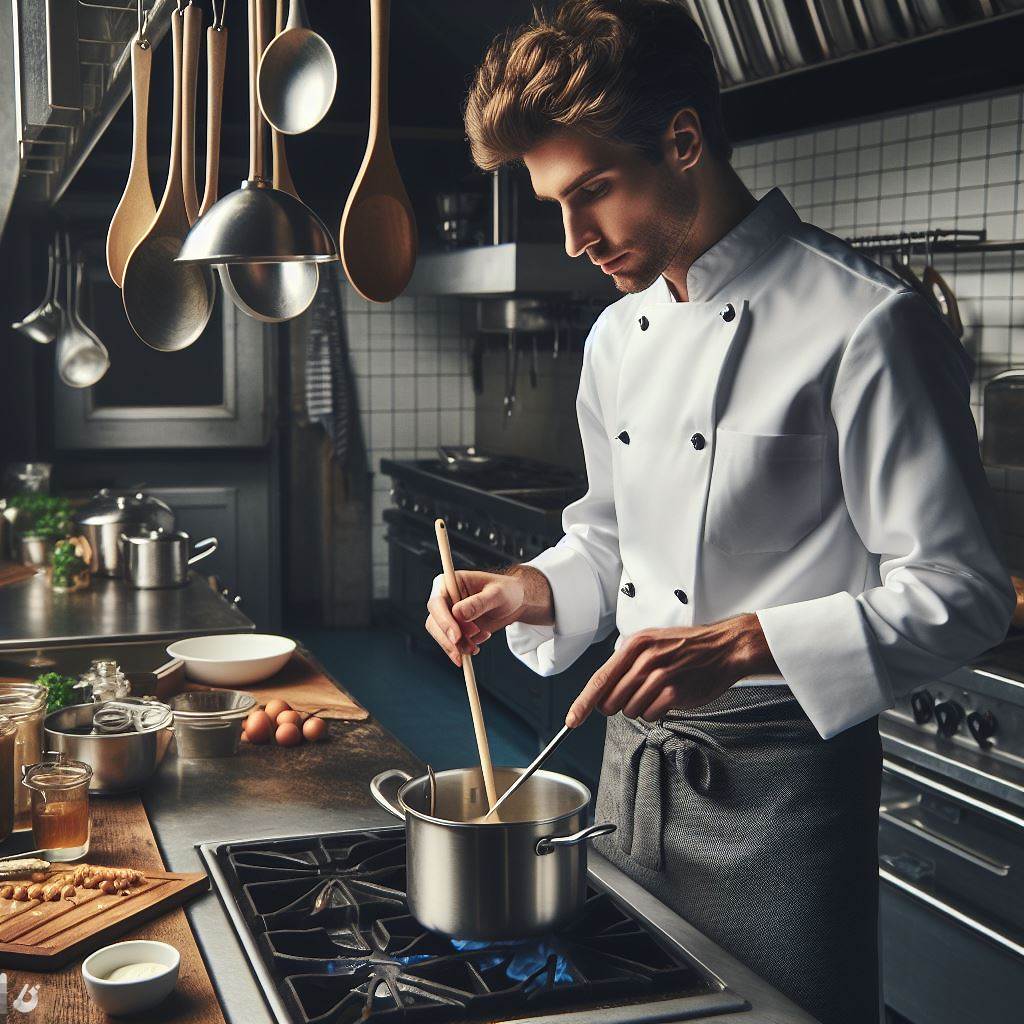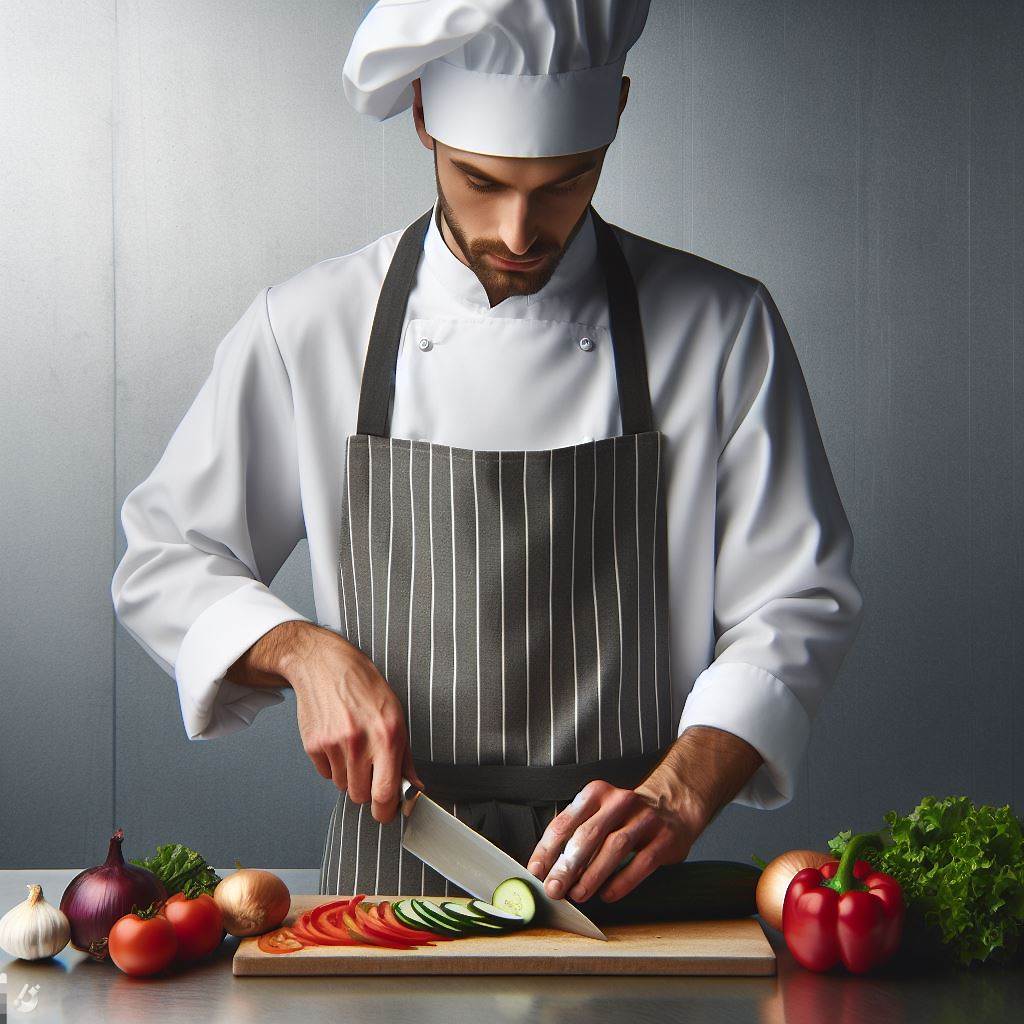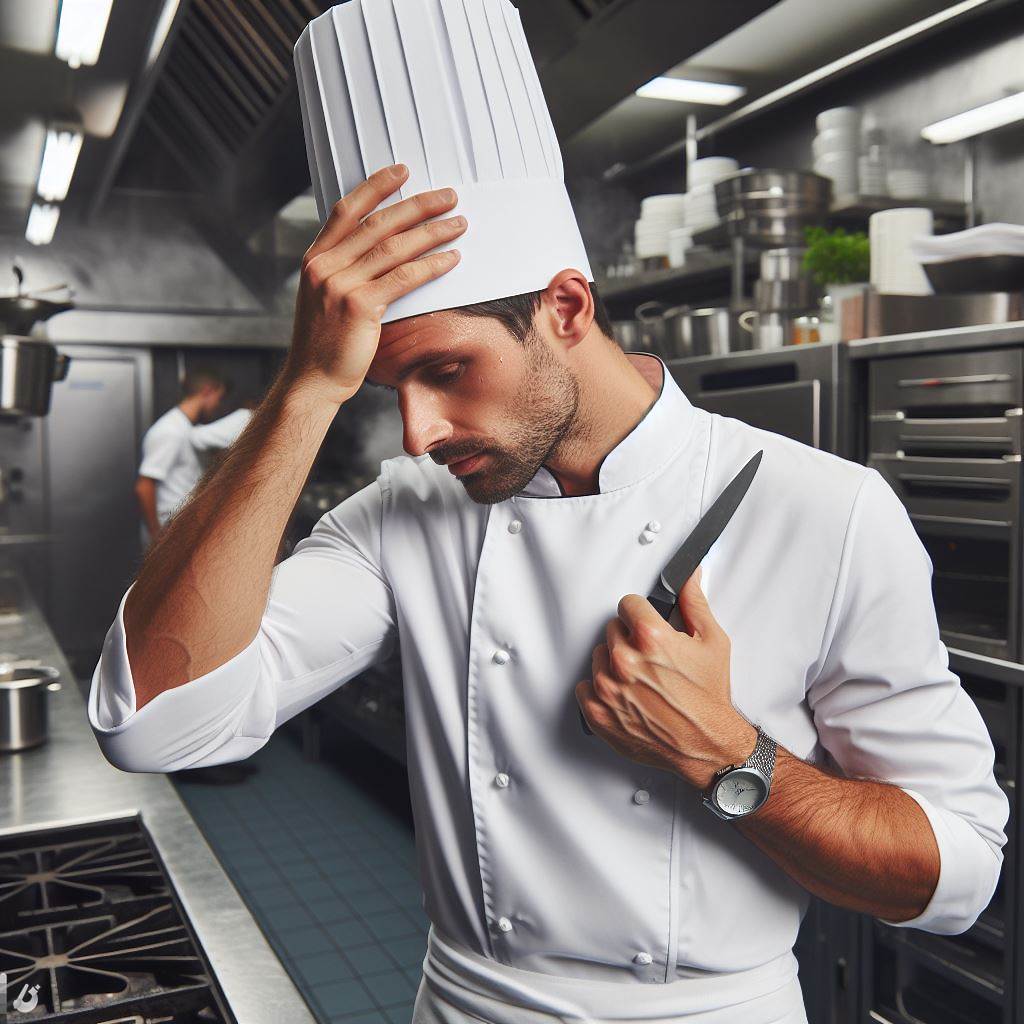Introduction
A Michelin star is a prestigious culinary award that signifies exceptional quality and expertise in a restaurant. It is highly regarded in the culinary world as a mark of excellence.
In this blog post, we will explore a day in the life of a Michelin star chef in the UK.
A Michelin star chef’s daily routine revolves around precision, creativity, and dedication to delivering extraordinary dining experiences.
From the moment they wake up, their focus is on creating culinary masterpieces that will wow their guests.
The chef meticulously plans their menu, carefully selecting ingredients that will marry together to create unique flavors and textures.
They guide and inspire their team, pushing them to deliver perfection on every plate.
Throughout the day, the chef is in constant motion, overseeing preparations, meticulously plating dishes, and tasting to ensure everything meets their exacting standards.
They embody discipline and attention to detail, scrutinizing every element of the dining experience.
Outside of the kitchen, the Michelin star chef engages with food enthusiasts, sharing their passion through cooking demonstrations and hosting special events.
They constantly seek inspiration, experimenting with new ingredients and techniques to push the boundaries of their culinary expertise.
As the day draws to a close, the chef reviews the day’s accomplishments and reflects on ways to improve.
They are always striving for perfection, committed to refining their craft and surpassing expectations in the ever-evolving world of gastronomy.
In short, a Michelin star chef’s life is a testament to passion, creativity, and an unwavering commitment to culinary excellence.
Their dedication to their craft is what sets them apart, making the dining experience an extraordinary journey for all who have the pleasure of savoring their artistry.
Education and Training
The educational background and culinary training required to become a Michelin star chef
To become a Michelin star chef, one must have a strong educational background and culinary training.
Personalized UK Career Consulting
Receive tailored career guidance designed just for you. Get actionable steps and expert support to boost your career in 1-3 days. Take control of your career now.
Get StartedCulinary schools offer diploma and degree programs that provide a solid foundation in culinary techniques.
These programs cover a range of topics including food preparation, cooking methods, nutrition, and kitchen management.
Many Michelin star chefs have also pursued specialized courses in areas such as pastry or international cuisine.
The importance of apprenticeships and hands-on experience in the culinary industry
In addition to formal education, hands-on experience is crucial in the culinary industry.
Apprenticeships and internships allow aspiring chefs to learn from experienced professionals in real kitchen settings.
Working in a professional kitchen provides invaluable training in multitasking, teamwork, and time management.
Michelin star chefs often spend years honing their skills in various high-end restaurants and establishments.
During this time, they learn to work under pressure and deliver consistently exceptional dishes.
Successful chefs invest time in continuous learning, attending workshops and classes to stay updated with trends.
The culinary industry is highly competitive, so chefs must constantly strive for excellence and innovation.
Networking is essential for aspiring Michelin star chefs, as it opens doors to new opportunities and collaborations.
Building relationships with industry professionals can lead to mentorship and guidance in career development.
Chefs often participate in culinary competitions to showcase their skills and gain recognition in the industry.
The journey to becoming a Michelin star chef requires immense dedication, passion, and perseverance.
Your Dream Job Starts with a Perfect CV
Get a tailored CV and cover letter that captures your unique strengths and stands out in your industry. Let us help you make an unforgettable first impression.
Get StartedIt is not just about cooking skills, but also creating unique flavors, presenting dishes beautifully, and providing an exceptional dining experience.
The demand for Michelin star chefs is high, and they are often sought after by prestigious restaurants and hotels.
Achieving a Michelin star is a testament to a chef’s talent, creativity, and commitment to culinary excellence.
Ultimately, education, training, hands-on experience, and continuous self-improvement are key ingredients for success in the culinary industry.
Aspiring chefs must embrace the challenges, embrace the steep learning curve, and embrace the passion for cooking.
Read: Mastering Travel Logistics: A UK Guide
Morning Routine Star Chef
Early mornings for a Michelin star chef are a whirlwind of activity and precise time management.
The day starts long before the sun rises, and every minute counts in order to deliver culinary excellence.
The early morning routine of a Michelin star chef
Waking Up
At the crack of dawn, the chef’s alarm rings, abruptly ending his slumber. Despite the grogginess, there is no room for laziness.
The chef jumps out of bed, ready to seize the day.
Preparing for the Day
With a meticulous eye for detail, the chef meticulously plans his menu and list of ingredients needed.
He reviews his recipes, ensuring all preparations are in order.
The chef then gets dressed, meticulously donning the traditional chef’s whites.
He ties his apron with care, representing the professionalism he upholds in the kitchen.
Optimize Your LinkedIn for Success
Boost your LinkedIn profile with a professional bio, keyword-rich headline, and strategic recommendations that attract recruiters. Stand out from the crowd and get noticed.
Optimize NowTraveling to the Restaurant
The chef heads out the door, bracing himself against the chilly morning air.
He walks briskly to the nearest subway station, eager to reach the bustling restaurant.
During the commute, the chef mentally prepares himself for the day ahead.
He visualizes the dishes he will create, anticipating the culinary delights that await his diners.
The Importance of Time Management and Efficiency in the Kitchen
In the world of Michelin star chefs, time is of the essence.
Every second in the kitchen is valuable and must be utilized effectively to deliver impeccable meals.
Organizing the Kitchen
Upon arrival, the chef surveys the kitchen, ensuring everything is clean, organized, and ready to be utilized.
Time wasted searching for utensils is unacceptable.
The ingredients are checked, and any missing items are immediately ordered.
The chef believes in maintaining a well-stocked kitchen, ready to whip up culinary wonders at a moment’s notice.
Delegating Tasks
The chef assigns specific tasks to his team, outlining their responsibilities and setting clear deadlines.
This distribution of tasks allows for smoother operations and enhances efficiency.
He emphasizes the importance of effective communication amongst the kitchen staff.
Timely updates and coordination are vital to ensuring a seamless execution of each dish.
Preparing the Workstations
Each workstation is meticulously prepped, with ingredients and utensils arranged in an ergonomic and systematic manner.
This thoughtful layout minimizes movement and maximizes efficiency.
The chef values proper mise en place, ensuring every ingredient is measured, chopped, and ready to be used.
A well-organized workspace is the foundation of culinary excellence.
Commencing Culinary Artistry
The chef orchestrates the kitchen with precision and finesse.
Flames dance beneath pans as ingredients sizzle and mix together harmoniously.
He constantly checks the progress of his team, providing guidance when needed and maintaining a watchful eye to ensure nothing falls short of perfection.
Time for Service
As the clock inches closer to opening time, the kitchen buzzes with excitement.
The chef and his team plate each dish with utmost care and attention to detail.
With synchronicity, the plates are brought out, delighting the waiting diners.
The chef’s heart races with anticipation, eager to witness the joy his creations bring to others.
In fact, a Michelin star chef’s morning routine is a whirlwind of preparation, organization, and dedication to achieving culinary excellence.
Time management and efficiency are sacred principles in the kitchen, ensuring every second counts in delivering outstanding gastronomic experiences.
Read: The Role of Sustainability in Travel Planning
Preparation and Planning
The chef’s involvement in the menu creation and planning process
When it comes to the menu creation and planning process, the UK Michelin star chef is deeply involved.
They take charge of every detail, ensuring that each dish represents their culinary vision and expertise.
Collaborating with Suppliers
One crucial aspect for the chef is sourcing high-quality ingredients for their restaurant.
They understand that using top-notch ingredients is the foundation of a remarkable dining experience.
To achieve this, they engage in close collaboration with local suppliers.
Building Relationships
The chef recognizes the importance of building strong relationships with their suppliers.
By doing so, they gain access to the freshest produce available in the market.
Regular communication allows the chef to stay updated on seasonal availability and even occasionally request specific ingredients.
Furthermore, collaborating with local suppliers offers several advantages.
Not only does it support the regional economy, but it also reduces the carbon footprint as ingredients can be sourced closer to the restaurant.
Trips to the Market
As part of their planning process, the chef frequently visits local farmers markets and specialty shops.
This allows them to personally handpick the finest ingredients, assessing their quality and suitability for their creations.
Browsing through vibrant displays of fruits, vegetables, meats, and seafood, the chef’s keen eye identifies exceptional products that align with their menu concepts.
Sourcing ingredients from these markets guarantees freshness and a direct connection to local producers.
Crafting the Menu
Once all the ingredients are carefully chosen, the chef begins the process of crafting the menu.
They consider the balance of flavors, textures, and colors in each dish, ensuring a harmonious culinary experience.
Fusion of Creativity and Expertise
The chef’s involvement in menu creation is a fusion of creativity and culinary expertise.
Drawing inspiration from their experiences, they experiment with innovative combinations while maintaining respect for traditional cooking techniques.
Constantly pushing boundaries, the chef seeks to surprise and delight their guests, offering a memorable dining experience that showcases their distinct style.
Achieving Balance
Beyond the flavors and techniques, the chef focuses on achieving balance in their menu.
They carefully consider the sequence of dishes, ensuring a gradual progression of flavors and textures throughout the meal.
From lighter, more delicate starters to richer, more robust main courses, the chef aims to create a well-rounded dining experience that leaves guests satisfied and impressed.
Adapting to Seasonal Changes
A crucial aspect of the chef’s menu planning is adapting to seasonal changes.
As the availability of certain ingredients fluctuates, they make necessary adjustments to their offerings.
The chef embraces the challenge of working with what nature provides, creating dishes that highlight the best ingredients of each season.
This flexibility ensures that guests taste the freshest produce at the peak of its flavor.
The Quest for Perfection
Throughout the entire preparation and planning process, the UK Michelin star chef maintains a relentless pursuit of perfection.
Their attention to detail and dedication to sourcing the finest ingredients ensure that every dish served tells a story.
The chef’s involvement in menu creation and collaboration with local suppliers result in a dining experience that is innovative, sustainable, and truly extraordinary.
Read: Building Client Trust as a Travel Advisor
Kitchen Operations
In this section, we will explore the daily responsibilities of a Michelin star chef in managing and coordinating the kitchen staff, including sous chefs, line cooks, and apprentices.
We will also delve into the fast-paced and high-pressure environment that they operate in.
Managing and Coordinating the Kitchen Staff
A Michelin star chef holds the pivotal role of overseeing kitchen operations, ensuring everything runs smoothly and efficiently.
Their responsibilities include:
- Hiring and training new kitchen staff members, from sous chefs to line cooks and apprentices.
- Assigning specific roles and responsibilities to each staff member, based on their skills and experience.
- Creating a collaborative and harmonious work environment, fostering teamwork and mutual respect.
- Developing work schedules, taking into account the demands of the restaurant and the skills of the staff.
- Ensuring the quality and consistency of food preparation by implementing strict standards and procedures.
- Monitoring inventory levels, ordering ingredients, and managing the kitchen budget.
- Overseeing the preparation and plating of dishes to meet the highest standards of presentation.
The Fast-Paced and High-Pressure Environment
Working in a Michelin star kitchen is not for the faint-hearted.
The environment is characterized by its fast pace and high levels of pressure.
Here are some key aspects of the kitchen environment:
- Intense Time Constraints: The kitchen staff must work within tight deadlines to ensure all dishes are prepared and served promptly.
- Precision and Perfection: Each dish must be prepared with meticulous attention to detail, ensuring it meets the high standards expected by the Michelin guide.
- Coordination and Communication: The entire kitchen staff must work together in perfect harmony, coordinating their tasks and communicating effectively to avoid any mistakes or delays.
- Adapting to Changing Circumstances: The kitchen staff must be flexible and quick-thinking, able to handle unexpected challenges and adjustments to the menu or customer demands.
- Endurance and Stamina: Long hours and physically demanding work are common in a Michelin star kitchen. The staff must have the stamina to sustain the pace throughout the day.
- Creative Pressure: While precision is essential, the chef and their team are also expected to push the boundaries of culinary creativity, continuously striving for innovation and uniqueness.
- Customer Satisfaction: In the midst of the chaos, the ultimate goal is to ensure that guests have a memorable dining experience, leaving the restaurant satisfied and delighted.
In essence, a Michelin star chef’s role goes beyond merely creating exquisite dishes.
They are responsible for managing and coordinating the diverse team in the kitchen, all while operating in a fast-paced, high-pressure environment.
It takes exceptional leadership skills, culinary expertise, and the ability to thrive under intense pressure to excel in this role.
Read: Travel Consultant Salary Trends in the UK

Cooking Techniques and Creativity
The Artistry Behind Michelin Star Dishes
In the bustling kitchen of a renowned Michelin star restaurant, the chef’s culinary skills and techniques take center stage.
With each dish meticulously crafted, they aim to create unique and innovative culinary experiences.
- Sous Vide Method: The chef masterfully employs the sous vide method, which involves vacuum-sealing ingredients and cooking them at precise temperatures. This technique locks in flavors and ensures unparalleled tenderness.
- Molecular Gastronomy: Pushing culinary boundaries, the chef revels in the world of molecular gastronomy. Through the use of scientific principles, they transform familiar ingredients into whimsical textures and eye-catching presentations.
- Fermentation: Fermented ingredients add depth and complexity to dishes. Harnessing the power of fermentation, the chef creates signature flavors that tickle the taste buds and leave diners wanting more.
- Smoke and Infusion: Utilizing smoke and infusion techniques, the chef imparts depth and smokiness to their creations. Whether it’s infusing delicate meats with aromatic flavors or creating smoky emulsions, these methods elevate the dishes to unforgettable heights.
- Deconstruction: Deconstruction is a technique that entails breaking down traditional dishes into their individual components. The chef skillfully reconstructs these elements to create innovative yet nostalgic dishes that challenge diners’ expectations.
- Foraging and Locally Sourced Ingredients: The chef celebrates the rich biodiversity of their surroundings by foraging for unique ingredients. Incorporating these locally sourced treasures, they create dishes that showcase the essence of the region and support sustainable practices.
The Role of Experimentation and Creativity
Michelin star standards demand constant evolution and innovation. Experimentation and creativity play vital roles in maintaining these standards.
- Pushing Boundaries: The chef constantly challenges conventional cooking norms, unafraid to step outside their comfort zone. By experimenting with new ingredients, flavors, textures, and techniques, they uncover uncharted culinary territory.
- Developing Signature Dishes: Through creative exploration, the chef develops signature dishes that become iconic representations of their culinary style. These dishes embody the chef’s unique perspective and are eagerly anticipated by diners.
- Collaborating with the Team: Creativity thrives through collaboration. The chef encourages their team to contribute ideas, fostering an environment where creativity is nurtured. Each team member’s unique perspective adds depth and richness to the culinary tapestry.
- Engaging with the Senses: Recognizing that dining is a multisensory experience, the chef creates dishes that engage not only the palate but also sight, smell, and touch. Utilizing aesthetic plating techniques, tantalizing aromas, and unique textures, they create a feast for the senses.
- Reinventing Classics: Tradition and innovation intertwine as the chef reinvents classic dishes with a contemporary twist. Respectful of culinary heritage, they breathe new life into time-honored recipes, marrying tradition with their own creative flair.
In general, a day in the life of a Michelin star chef is a testament to their extraordinary culinary skills.
Through their mastery of various techniques and unwavering creativity, they elevate the dining experience to an art form.
Service and Customer Interaction
The chef oversees the food presentation to ensure it meets high standards of quality and taste.
The chef’s role in maintaining the restaurant’s reputation for exceptional food is crucial.
Customer satisfaction is of utmost importance to the chef, as they strive to exceed expectations.
The chef interacts with patrons, greeting them and ensuring their overall dining experience is enjoyable.
Handling special requests is a common occurrence, and the chef ensures they are accommodated to the best of their abilities.
Understanding and respecting dietary restrictions is crucial in providing a personalized dining experience.
The chef takes the time to explain menu options and make recommendations based on individual preferences.
Customer feedback is valued by the chef as it helps them to continuously improve their offerings.
Maintaining open lines of communication with the front-of-house staff is vital.
Being flexible and resourceful allows the chef to handle any situation that may arise during service.
Attention to detail is a key aspect of ensuring customer satisfaction.
The chef ensures that every dish leaving the kitchen meets the highest quality standards.
Continuous training and education help the chef stay updated with new techniques and culinary trends.
Adopting a hands-on approach, the chef regularly communicates with the kitchen staff to maintain consistency.
Maintaining a positive and professional attitude at all times is a priority for the chef.
Continuous Learning and Improvement
In the competitive world of culinary arts, staying up to date with the latest trends and constantly improving one’s skills is essential to succeed.
This commitment to continuous learning is even more pronounced for a Michelin star chef, who strives for culinary excellence and maintaining their prestigious ratings.
Importance of Staying Updated
- A Michelin star chef understands that the culinary landscape is ever-evolving and embraces the importance of staying updated.
- They actively seek out new cooking techniques, ingredients, and flavor combinations.
- Attending workshops, conferences, and even collaborating with other top chefs are all part of their continuous learning process.
- They remain curious and open-minded, always willing to experiment and explore new possibilities.
Embracing Culinary Trends
- Staying ahead of culinary trends is crucial for a Michelin star chef to keep their menus fresh and appealing to diners.
- They avidly follow food blogs, read industry publications, and even travel to different countries for inspiration.
- Visiting local markets, sampling street food, and engaging with local cooks allows them to grasp the essence of various cuisines.
- They seamlessly blend traditional techniques with contemporary trends, creating unique and extraordinary culinary experiences.
The Quest for Michelin Stars
- The coveted Michelin star ratings are a testament to a chef’s talent, craftsmanship, and dedication to culinary perfection.
- Obtaining a Michelin star is an arduous journey that involves exceptional skills, consistency, and attention to detail.
- Chefs who aspire to achieve this prestigious accolade undergo intense training and work in Michelin-starred restaurants to gain experience.
- Maintaining Michelin stars is equally challenging. Inspection visits from anonymous reviewers keep chefs on their toes.
- From impeccable food quality and presentation to outstanding service, every aspect of the dining experience is scrutinized.
The Pressure and Rewards
- The pursuit of continuous learning and maintaining Michelin star ratings comes with immense pressure.
- Chefs are under constant scrutiny, with high expectations from both customers and the culinary world.
- However, the rewards are equally remarkable. Michelin stars elevate a chef’s reputation and attract discerning food enthusiasts.
- Being recognized as a Michelin star chef opens doors to collaborations, book deals, and global recognition.
- Ultimately, continuous learning and improvement go beyond the quest for Michelin stars. It is a lifelong passion and dedication to the art of cooking.
In a nutshell, a day in the life of a UK Michelin star chef is a relentless pursuit of excellence.
Continuous learning, staying updated with culinary trends, and maintaining Michelin star ratings are all interconnected.
It is this unwavering commitment that sets them apart and fuels their creativity, resulting in exceptional dining experiences for discerning food enthusiasts.
Learn More: Wedding Planning in the UK: A Deep Dive
Work-Life Balance and Challenges
The challenges faced by Michelin star chefs, such as long working hours and intense pressure
Being a Michelin star chef in the UK is no easy task. These culinary masters face numerous challenges in their profession.
One of the most significant challenges is the long working hours that they have to put in.
A day in the life of a Michelin star chef typically starts early in the morning.
They have to be at the restaurant before anyone else to oversee the preparation for the day.
This means waking up at the crack of dawn, sometimes even before sunrise.
Once they arrive at the restaurant, the chef begins their day by reviewing the menu and discussing it with their team.
They ensure that all the ingredients are fresh and of the highest quality. This attention to detail is what sets them apart.
The next challenge they face is the intense pressure that comes with delivering top-notch cuisine.
As a Michelin star chef, they are constantly striving for perfection in every dish they create.
This pressure can be overwhelming and exhausting.
In addition to the pressure, they also have to deal with the high expectations of their customers.
People come to their restaurants expecting a meal like no other, and it is up to the chef to deliver an unforgettable culinary experience.
Strategies for achieving work-life balance and managing stress in a demanding profession
Managing stress and achieving work-life balance is crucial for a Michelin star chef.
Despite their demanding profession, they need to find time for themselves and their loved ones. Here are some strategies they use:
- Delegating tasks: Michelin star chefs understand the importance of delegation. They have a skilled team to support them in the kitchen.
- Setting boundaries: They set clear boundaries between work and personal life. They prioritize their well-being and try to leave work at work.
- Regular breaks: Taking regular breaks throughout the day helps them recharge and refocus. This allows them to maintain their energy levels and perform at their best.
- Physical activity: Engaging in physical activities like exercise or yoga helps them relieve stress and improves their overall well-being.
- Maintaining a healthy diet: Despite being surrounded by delicious food all day, Michelin star chefs understand the importance of eating healthy to stay physically and mentally fit.
They also take vacations and time off to spend with their families and loved ones.
Disconnecting from work and enjoying leisure activities is essential for their mental well-being.
Despite the challenges, being a Michelin star chef is incredibly rewarding.
The recognition and respect they receive from their peers and customers make all the hard work worthwhile.
It is a profession that demands passion, dedication, and constant growth.
So, the next time you dine at a Michelin-starred restaurant, remember the dedication and sacrifices that the chef has made to create that exceptional dining experience for you.
Conclusion
Becoming a Michelin star chef in the UK requires immense passion, dedication, and hard work.
In this blog section, we explored a day in the life of a UK Michelin star chef, highlighting the intense creativity and effort involved.
In this culinary journey, we delved into a Michelin star chef’s dynamic day.
From dawn’s prep to midnight reflections, each moment honed expertise.
Precision in plating, mastery in flavors, and a constant pursuit of excellence defined their path.
Passion and dedication are the driving forces. A relentless commitment to craft fuels the pursuit of Michelin recognition.
It’s more than a career—it’s a lifestyle, a calling that demands resilience and creativity.
As we savor the exquisite dishes, let’s acknowledge the toil, creativity, and sacrifice behind the scenes.
Every Michelin star earned is a testament to a chef’s unwavering dedication.
It is important for readers to appreciate the culinary achievements and recognize the incredible talent behind these prestigious accolades.
Support and appreciate the culinary artistry that enriches our dining experiences. Chef life, a labor of love.




